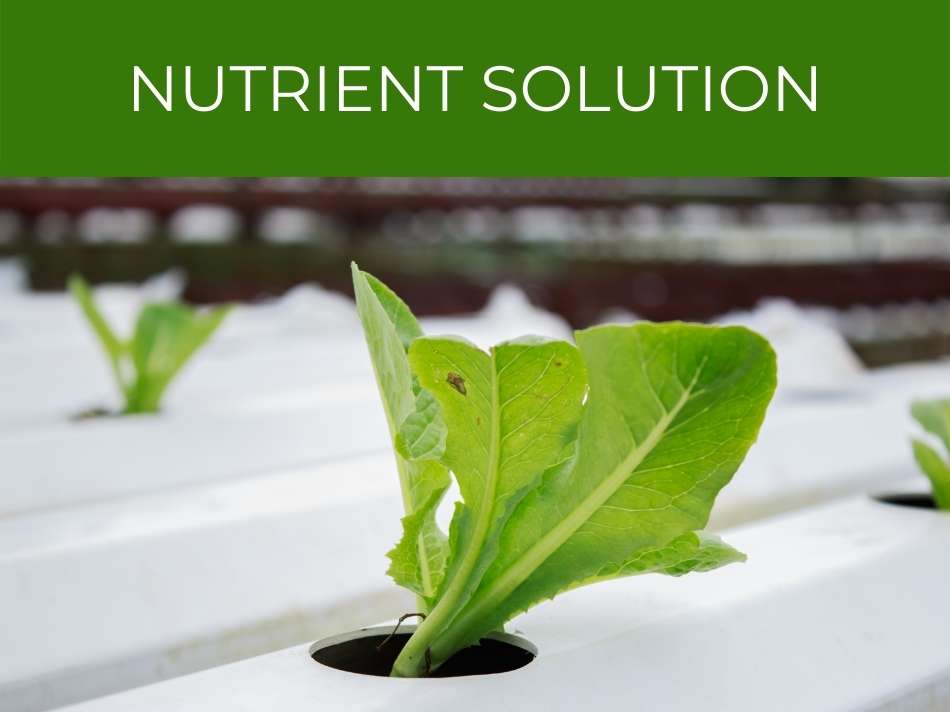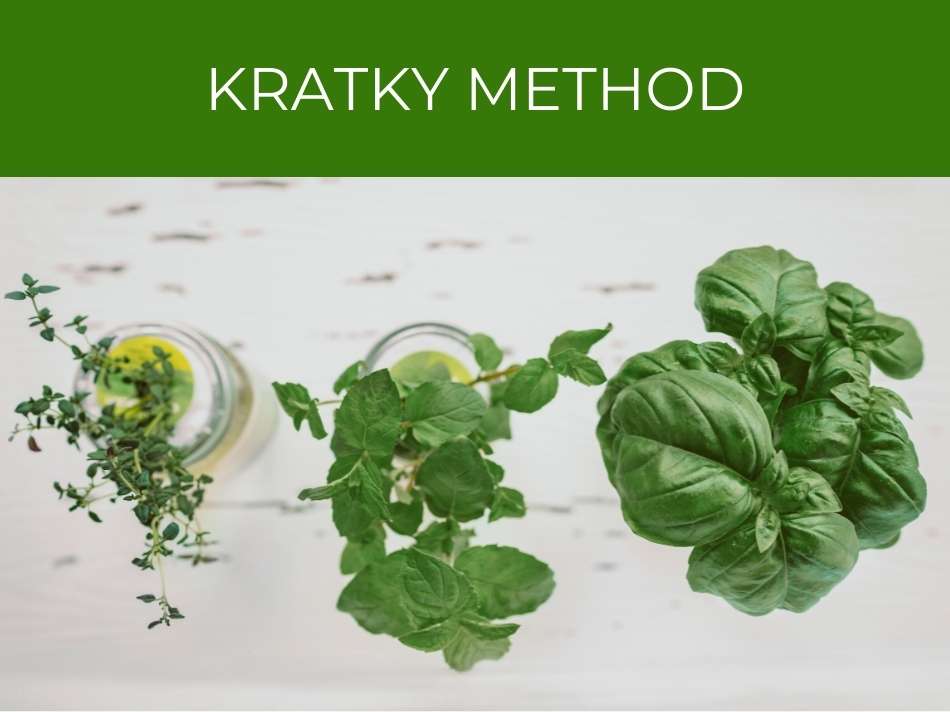The Kratky method is a hydroponic growing technique that is adaptable and scalable from small scale home growers to large scale production. Plants grown using hydroponics use less water and space while producing higher yields. This method was first introduced in 2009 by Bernard Kratky in the journal Acta Horticulturae.
The Kratky method is a hydroponic growing method that involves suspending plants over nutrient-rich water in a reservoir. As the plants grow, the water & nutrients are absorbed through the roots and the water level lowers, allowing the roots of the plant to obtain oxygen.
The Kratky method is simple and only requires 7 elements to get started. A grower will need: a container and lid, net pots, a growing medium, hydroponic fertilizer, a pH testing kit, and a ppm meter.
Find out if plants can grow without water.

Kratky method
The Kratky method is a very self-sufficient way of cultivating plants.
Plants are left to grow until harvest time and there is no need for electricity or water pumps in this hydroponic growth technique, making this a low maintenance system that can run by itself for weeks.

Plants are placed in a net pot with growing media such as rock wool. The pots are hung over a reservoir of water rich in macronutrients and micronutrients. The roots of the plants are partly submerged in the water to ensure the plants have access to oxygen and water.
Holes are drilled in the lid to hold the net pots containing the plants.
The container is then filled with water, followed by nutrients and then tested to ensure the proper pH balance.
Hydroponics, and more specifically, the Kratky method meets the need for innovative agriculture.
The net pot with growing media and plants are placed inside the holes, allowing the roots to be submerged in the water.
Find out how often the water in a hydroponic system should be changed.

Hydroponic system
A hydroponic system allows the grower to control the environment, at least to a certain extent, in which plants and herbs grow.
Over the past few years there have been several modifications to the hydroponic system that allow growers to provide plants with exactly what they need when they need it in order to yield bigger harvests.

A hydroponic system is a method for growing plants in a nutrient solution without using soil. The hydroponic system provides plants with water and essential nutrients normally supplied by soil, & can be fine-tuned for optimal plant growth.
There are six main types of hydroponic systems including the nutrient film technique (NFT), wicking, ebb and flow, deep water culture (DWC), drip systems, and aeroponics.
A hydroponic system does not require a greenhouse but can benefit from it.
These systems can be used in small-scale cultivation as well as much larger operations.
Find out if plants grow better in water or soil.

Nutrient solution
Plants need nutrients in order to grow.
Traditionally, these nutrients are obtained through the roots of the plant from the soil in which the plant grows.
However, with hydroponics, no soil is used in growing plants and therefore nutrients have to be added to the hydroponic system to ensure that plants are sufficiently nourished while in the growth cycle.

Nutrient solutions are a type of fertilizer for plants. The solutions consist of concentrated levels of minerals needed by the plants, such as nitrogen, phosphorus, potassium, & other micronutrients. These solutions can vary; some help plants flower while other nutrients encourage vegetative growth or fruit production.
The hydroponic system controls the rate at which the nutrients are fed to the plant.
Plants need 17 different types of nutrients without which the plants will wither and die.
These nutrient solutions are specifically designed to feed the plants exactly what they need when they need it.
Find out how old seedlings should be before you use nutrients.

Mason jar hydroponics
Mason jars are very popular for cultivating hydroponic plants.
Because no soil is used in hydroponic growing, there is no mess and this creates a budget-friendly option for those wanting to try out hydroponic growing without initially investing too much money.
Mason jar hydroponics is an alternative to indoor plant growing. Hydroponic plants are grown inside mason jars using a similar method to growing the plants in a large container. This allows for small-scale plant cultivation, & low-maintenance hydroponics.
Seeds are placed in moistened rock wool cubes that are placed inside small pots.
The pots are placed inside the mason jar.
The outside is enclosed to prevent sunlight from entering when the plant is in the night cycle.
The roots extend into the nutrient-rich water inside the mason jar.
See our complete article on automatic watering.

Kratky method mason jar
This method of plant cultivation is known as the 7th method.
It is by far the most inexpensive and easiest method to grow plants using the hydroponic system.
The Kratky mason jar method is a non-circulating hydroponics system. This system does not require a pump, aerator, or any electricity. Plants are suspended over water containing nutrients on a small scale. The plant is ready to harvest when there is no more water.
This method is for growers who do not have sufficient space in their yard or don’t have a yard at all.
Plants can be grown indoors, using a combination of a mason jar and the Kratky method.
It’s very simple to set up, looks very pretty, and is very low-maintenance.
See our complete guide on hydroponics versus soil.

Hydroponic lettuce
There are many plants and vegetables that grow exceptionally well using the hydroponic technique.
Some plants such as tomatoes, lettuce, spinach, bell peppers, etc.
Hydroponic lettuce refers to lettuce that has been grown using the hydroponic technique. Lettuce is one of the most common vegetables grown using this method. Lettuce is considered to be a very fast growing, highly-productive hydroponic crop.
Lettuce grown in a hydroponic system is essentially supercharged and will yield results in as quickly as six to eight weeks.
Lettuce grown using this method requires 18 hours of light per day and around six hours of darkness.
There are three types of lettuce that grow exceptionally well with hydroponics, including romaine lettuce, looseleaf, and butterhead lettuce.
Find out which vegetables grow best using hydroponics.

Hydroponic tomatoes
As previously mentioned, some vegetables thrive using the hydropic growth method.
One of the vegetables that grow really well with this method is tomatoes.
In fact, when tomatoes are grown in favorable conditions, using hydroponics methods, these plants can yield 30% to 50% faster than using traditional soil-based growth methods.
Hydroponic tomatoes are tomatoes that have been grown using the hydroponic method. These tomatoes are grown in nutrient solutions instead of soil. Additionally, hydroponic tomatoes can be grown indoors with artificial lighting, & can thus be grown year-round..
Hydroponically grown tomatoes require 16 – 18 hours of light per day in order to grow. This method results in higher yields and crops that grow considerably faster.
The tomatoes are usually grown from seedlings in alternative mediums to soil such as rock wool, perlite, sand, etc.
Keep in mind that the vegetables and plants cannot extract the nutrients they require from these alternatives to soil and therefore require that the grower adds nutrient mix to the water in which the plants are cultivated.

